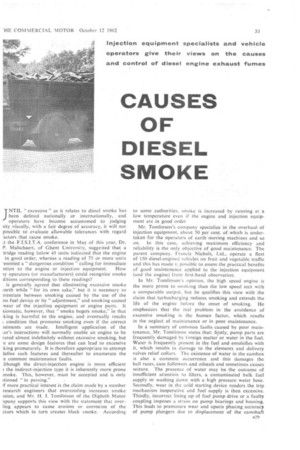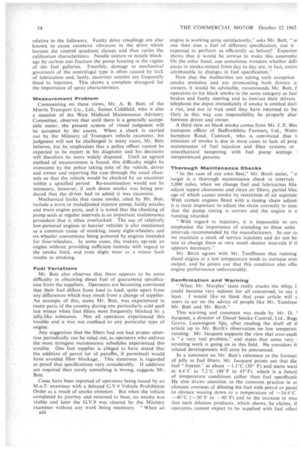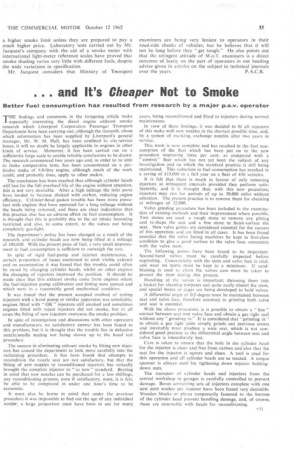CAUSES OF DIESEL SMOKE
Page 55

Page 56

Page 57

If you've noticed an error in this article please click here to report it so we can fix it.
JNTIL " excessive " as it relates to diesel smoke has been defined nationally or internationally, and operators have become accustomed to judging sity visually, with .a fair degree of accuracy, it will not possible to evaluate allowable tolerances with regard 'actors that cause smoke.
,t the F.I.S.I.T.A. conference in May of this year, Dr. P. Malschaert, of Ghent University, suggested that a .tridge reading below 45 units indicated that the engine in good order, whereas a reading of 75 or more units .esented a "dangerous condition " calling for immediate
ntion to the engine or injection equipment. How ty operators (or manufacturers) could recognize smoke ditions corresponding to these readings?
is generally agreed that eliminating excessive smoke rorth while "for its own sake," but it is necessary to rentiate between smoking caused by the use of the :ss fuel device or by "adjustment," and smoking caused wear of the injection equipment or engine parts. It domatic, however, that "smoke begets smoke," in that king is harmful to the engine, and eventually results t condition that promotes smoking even if the correct istments are made. Intelligent application of the :er's instructions will normally enable an engine to be rated almost indefinitely without excessive smoking, but e are some design features that can lead to excessive king prematurely. It is therefore appropriate to attempt lefine such features and thereafter to enumerate the c common maintenance faults.
Ithough the direct-injection engine is more efficient i the indirect-injection type it is inherently more prone .moke. This, however, must be accepted and is only itioned "in passing." .
rf more practical interest is the claim made by a number research engineers that overcooling increases smoke ssion, and Mr. H. J., Tomlinson of the Digbeth Motor apany supports this view with the statement that overling appears to cause erosion or corrosion of the ctors which in turn creates black smoke. According
to some authorities, smoke is increased by running at a low temperature even if the engine and injection equipment are in good order
Mr. Tomlinson's company specialize in; the overhaul of injection equipment, about 50 per cent. of which is undertaken for the operators of earth moving machines and so on. In this case, achieving maximum efficiency and reliability is the only objective of good maintenance. The parent company, Francis Nichols, • Ltd., operate a fleet of 150 diesel-engined vehicles on fruit and vegetable traffic and this has made it possible to assess the practical benefits of good maintenance applied to the injection equipment (and the engine) from first-hand observation.
In Mr. Tomlinson's opinion, the high speed engine is the more prone to smoking than the low speed unit with a comparable output, but he qualifies this view with the claim that turbocharging reduces smoking and extends the life of the engine before the onset of smoking. He emphasizes that the real problem in the avoidance of excessive smoking is the human factor, which results in the neglect of maintenance or in poor maintenance.
In a summary of common faults caused by poor maintenance, Mr. Tomlinson states that: firstly, pump parts are frequently damaged by foreign matter or water in the fuel. Water is frequently present in the fuel and emulsifies with it, which results in damage to the elements and delivery valves relief collars. The existence of water in the cambox is also a common occurrence and this damages the ball races, cam followers and oilseals and sometimes causes seizure. The presence of water may be the outcome of insufficient attention to filters, a contaminated bulk fuel supply or washing down with a high pressure water hose. Secondly, wear in the cold starting device renders the trip mechanism inoperative and fuel supply is then excessive. Thirdly, incorrect lining up of fuel pump drive or a faulty coupling imposes a strain on pump bearings and housing. This leads to premature wear and upsets phasing accuracy of pump plungers due to displacement of the camshaft
relative to the .followers. Faulty drive couplings are also known, to cause excessive vibration in the drive which loosens the control quadrant clamps and thus varies the calibration characteristics. Needle seizure or nozzle blockage by carbon can fracture the pump housing in the region of the fuel galleries. Fourthly, damage to mechanical governors of the centrifugal type is often caused by lack of lubrication and, lastly, incorrect nozzles are frequently fitted to injectors. This shows a complete disregard for the importance of spray characteristics.
Measurement Problem Commenting on these views, Mr. A. R. Butt, of the Morris Transport Co., Ltd., Sutton Coldfield, who is also a member of the West Midland Maintenance Advisory Committee, observes that until there is a generally acceptable meter, the present system of visual judgment will be accepted by the courts. When a check is carried out by the Ministry of Transport vehicle examiner, his judgment will not be challenged in many cases, Mr. Butt believes, but he emphasises that a police officer cannot be expected to be expert in his diagnosis and his decisions will therefore be more widely disputed. Until an agreed method of measurement is found, this difficulty might be overcome by the police taking note of the vehicle, driver and owner and reporting the case through the usual channels so that the vehicle would be checked by an examiner within a specified period. Re-examination would not be necessary, however, if such dense smoke was being produced that the driver had to admit it was excessive.
Mechanical faults that cause smoke, cited by Mr. Butt, include a worn or maladjusted injector pump, faulty nozzles and worn engine parts, and it is noted that the checking of pump seals at regular intervals is an important maintenance procedure that is often overlooked. The use of relatively low-powered engines in heavier vehicles is also mentioned as a common cause of smoking, many eight-wheelers and six-wheeler conversions being powered by engines intended for four-wheelers, In some cases, the makers up-rate an engine without providing sufficient latitude with regard to the smoke limit, and even slight wear or a minor fault results in smoking.
Fuel Variations Mr. Butt also observes that there appears to be some difficulty in obtaining diesel fuel of guaranteed specification from the suppliers. Operators are becoming convinced that their fuel differs from load to load, quite apart from any differences which may result from a change of supplier. An example of this, states Mr.. Butt, was experienced in many parts of the country during one particularly cold spell last winter when fuel filters were frequently blocked by a jelly-like substance. Not all operators experienced this tremble and it was not confined to any particular type of engine.
Any suggestion that the filters had not had proper attention periodically can be ruled out, As operators who enforce. the most Stringent maintenance schedules experienced this trouble. One fuel supplier is alleged to have stated that the addition of petrol (or of paraffin, if permitted) would have avoided filter blockage. This statement is regarded as proof that specifications vary considerably. If additives are required then surely something is wrong, suggests Mr. Butt.
Cases have been reported of operators being issued by an M.o.T. examiner with a delayed G.V.9 Vehicle Prohibition Order as a result of smoke emission. But when the vehicle completed its journey and returned to base, no smoke was visible and later the G.V.9 was cleared by the Ministry examiner without any work being necessary. "When an a30 engine is working quite satisfactorily," asks Mr. Butt, " al one then uses a fuel of different' specification, can it expected to perform as efficiently as before? Experien shows that it would be unwise to make this assumptio On the other hand, one sometimes wonders whether cliff( ences in smoke-output from day to day are, in fact, entire attributable to changes in fuel specification."
Now that the Authorities are taking such exception smoke emission and are prosecuting both drivers ai owners, it would be advisable, recommends Mr. Butt, f Operators to list black smoke in the same category as faul brakes and faulty steering and to instruct their drivers telephone the depot immediately if smoke is emitted dun' a run, and not to wait until they have returned to ba: Only in this way can responsibility be properly shar between driver and owner.
A third view on black smoke comes from Mr. J. E. Birc transport officer of Staffordshire Farmers, Ltd., Wolvt hampton Road, Cannock, who is convinced that t emission of smoke is due in most cases to lack of prop maintenance of fuel injection and filter systems or unauthorized tampering with fuel pump settings I inexperienced persons.
Thorough Maintenance Checks "In the case of our oWn fleet," Mr. Birch states, " target is a thorough maintenance check at intervals 5,000 miles, when we change fuel and lubrication filte adjust tappet clearances and clean air filters, partial bloc age of which causes smoke by restriction of air aspiratic With certain engines fitted with a•timing chain adjust it is most important to adjust the chain correctly to ensu that the pump timing is correct and the engine is n running retarded.
"With regard to injectors, it is impossible to ovc emphasize the importance of attending to these units intervals recommended by the manufacturers. In our ca we maintain a stock of service injectors and do not he tate to change them at very much shorter intervals if ti appears necessary."
Mr. Birch agrees with Mr. Tomlinson that running diesel engine at a low temperature tends to increase smo output, and he points out that this condition also affec engine performance unfavourably.
Confirmation and Warning
"When .Mr. Marples' team really cracks the whip, Ii could become very tedious for all concerned, to say t least I would like to think that your article will s users to act on the advice of people like Mr. Tomlinsc Mr. Butt and Mr. Birch."
This warning and comment was made by .Mr. D. 1 Jacquest, a director of Diesel Smoke Control, Ltd., Rege Grove,Leamington Spa, after reading the draft of ti article up to Mr. Birch's observation on low temperatu running. Mr. Jacquest supports the view that over-cooli -is "a very real problem," and states that some very i teresting work is going on in this field. He considers ti related developments will soon be announced.
In a comment on Mr. Butt's reference to the forrnati of jelly in fuel filters, Mr. Jacquest points out that die fuel "freezes" at about —1.1°C (30° F) and starts waxi at 4.4°C to 7.2°C (40°F to 45°F), which is a functi of temperature conditions rather than fuel specificatic He also draws attention to the common practice in cc climates overseas of diluting the fuel with petrol or paraf to obviate waxing down to a temperature of —34.4°C —40°C (-30°F to —40°F) and to the increase in smo that such dilution produces, which shows, he claims, a operators cannot expect to be supplied with fuel offeri a higher smoke limit unless they are prepared to pay a much higher price. Laboratory tests carried out by Mr. Jacquest's company with the aid of a smoke meter with international light-meter reference scales have proved that smoke shading varies very little with different fuels, despite the wide variations in specification.
Mr. Jacquest considers that Ministry of Transport examiners are being very lenient to operators in their road-side checks of vehicles, but he believes that it will not be long before they "get tough." He also points out that the stringent attitude of M.o.T. examiners, is a direct outcome of laxity on the part of operators in not heeding advice given in articles on the subject in technical journals over the years P.A.C.B.




















































































































